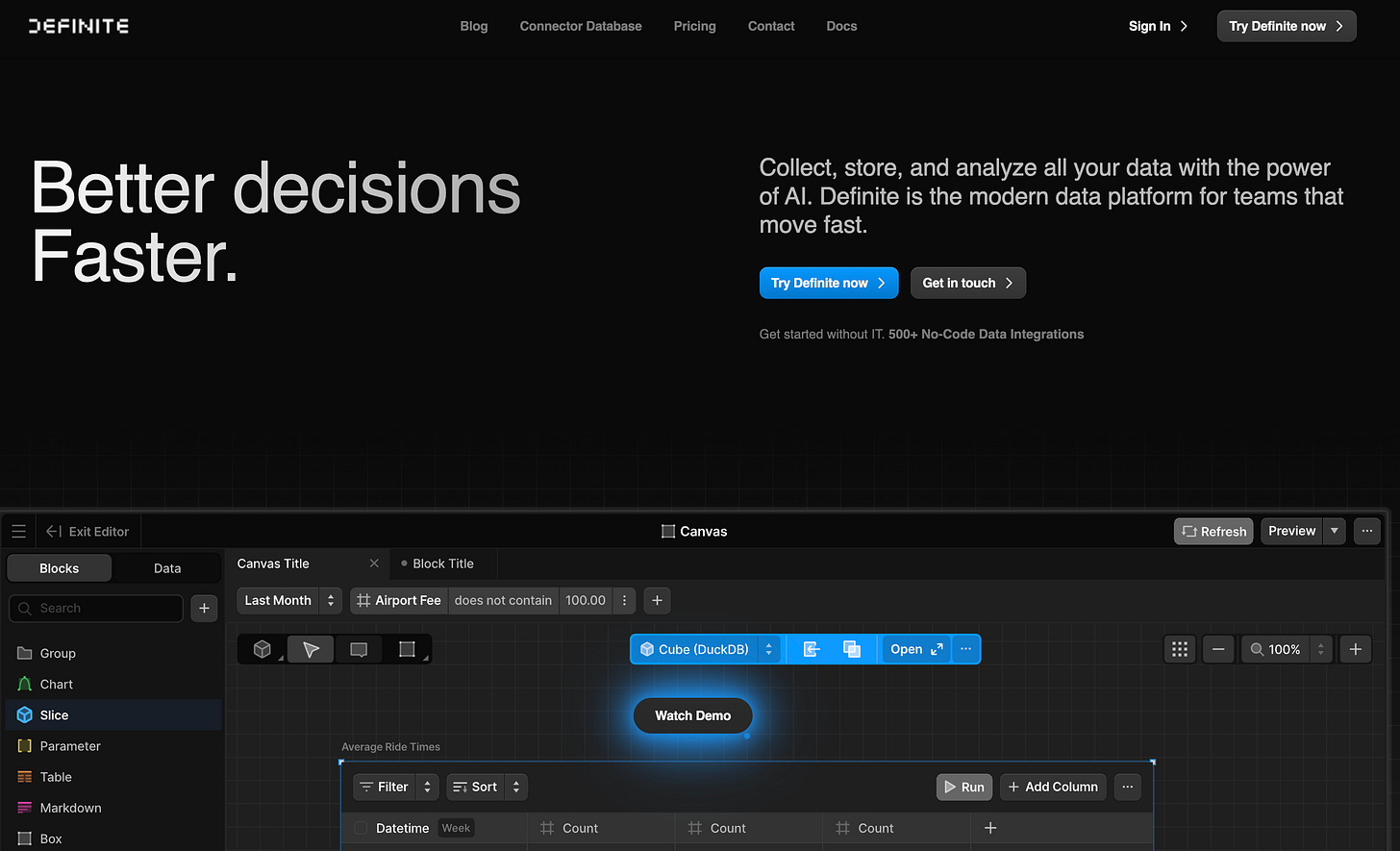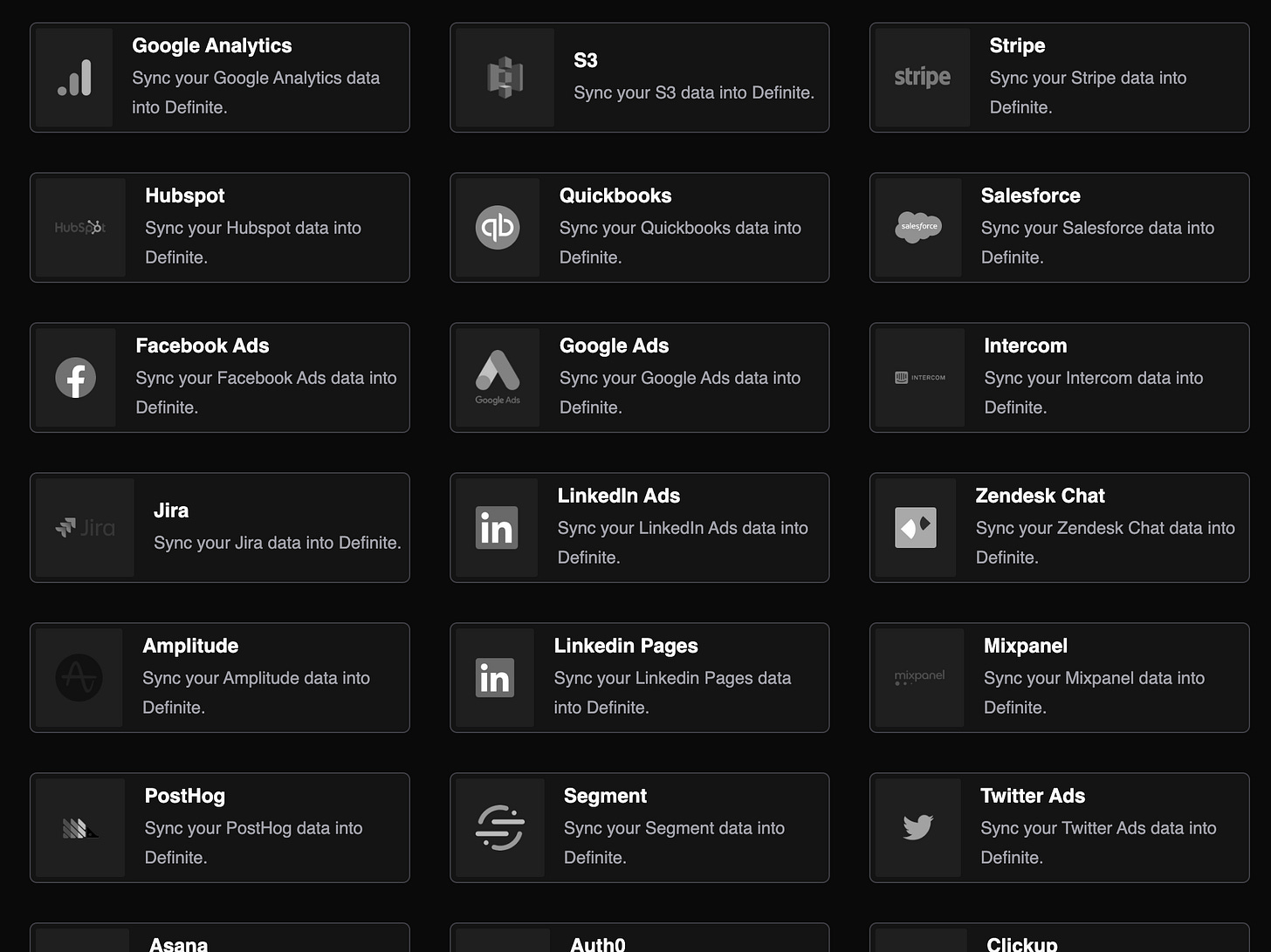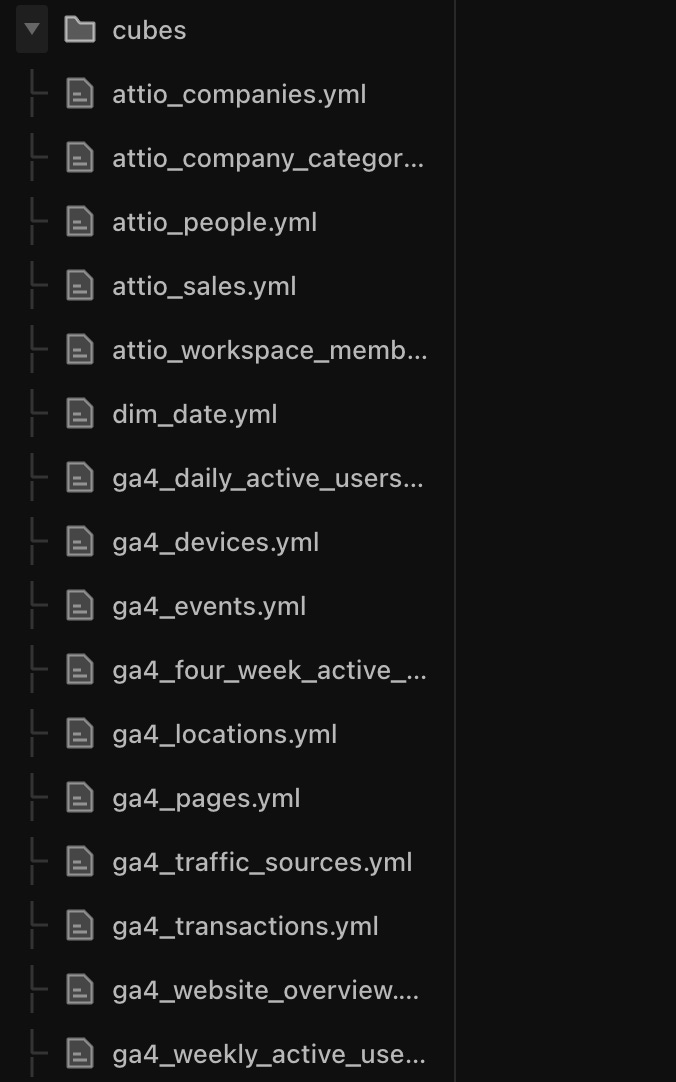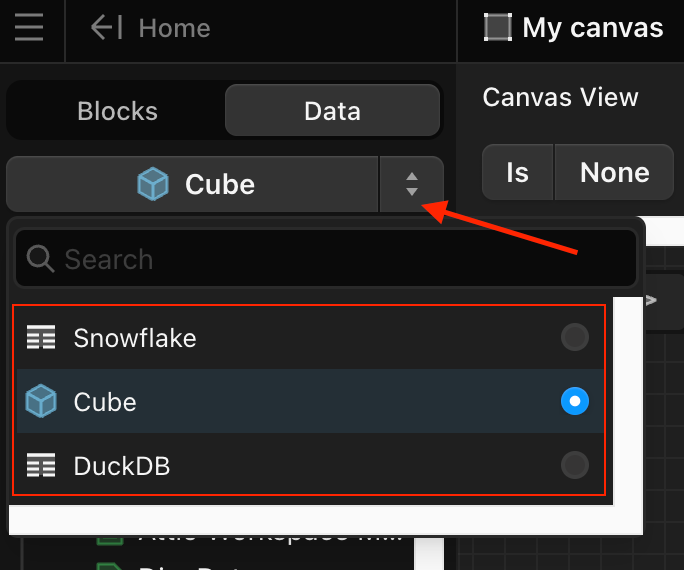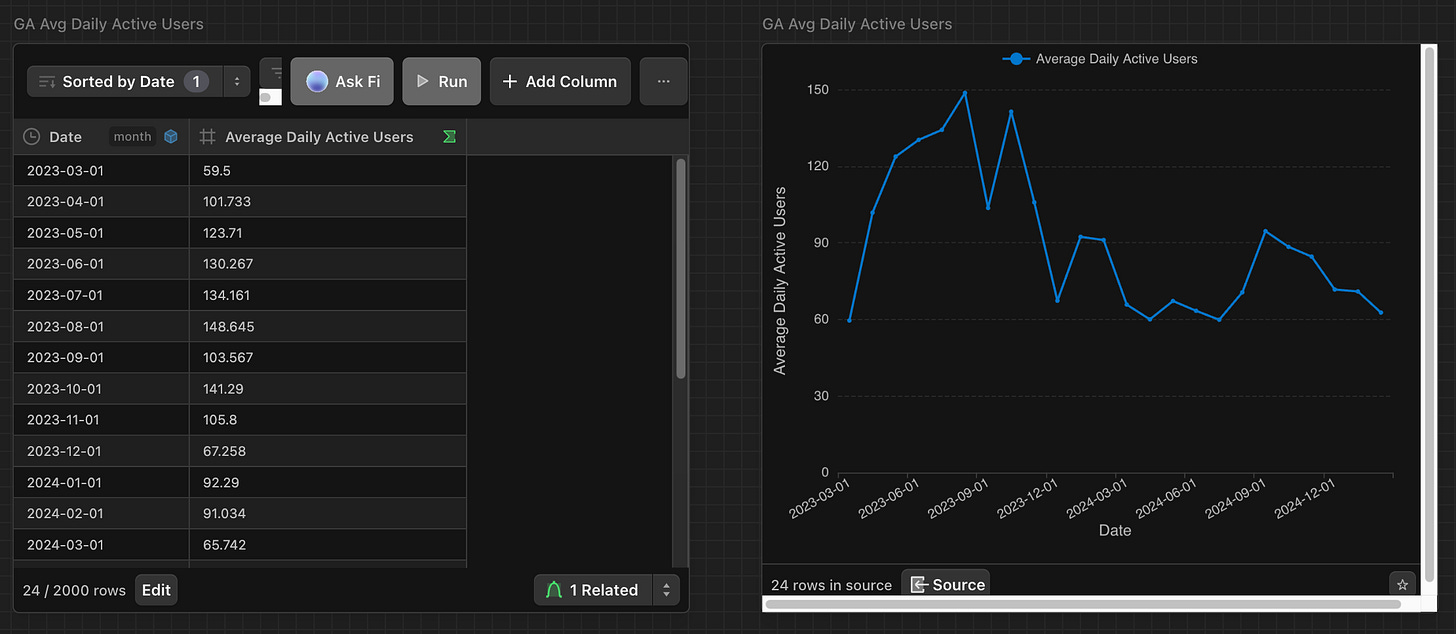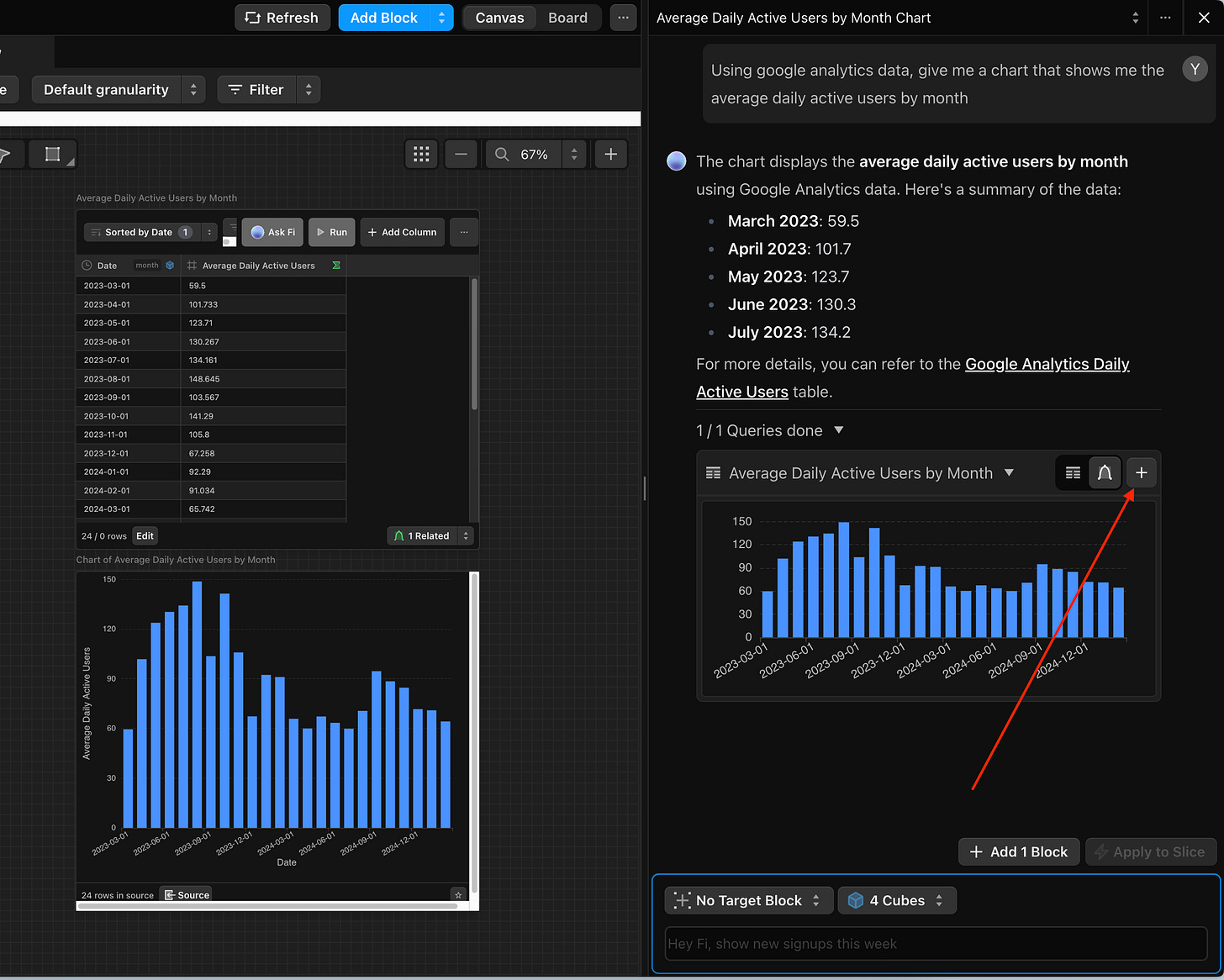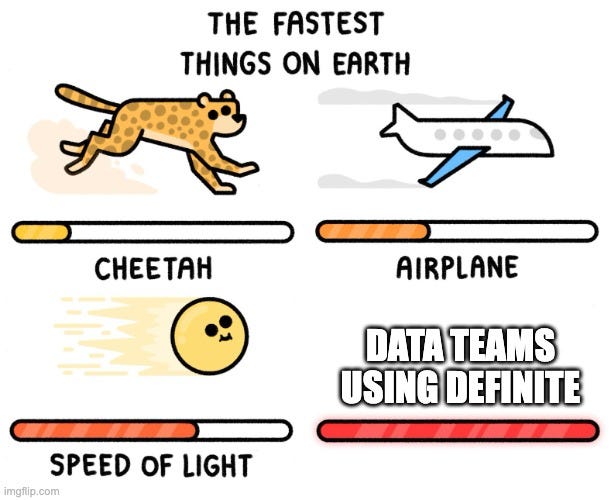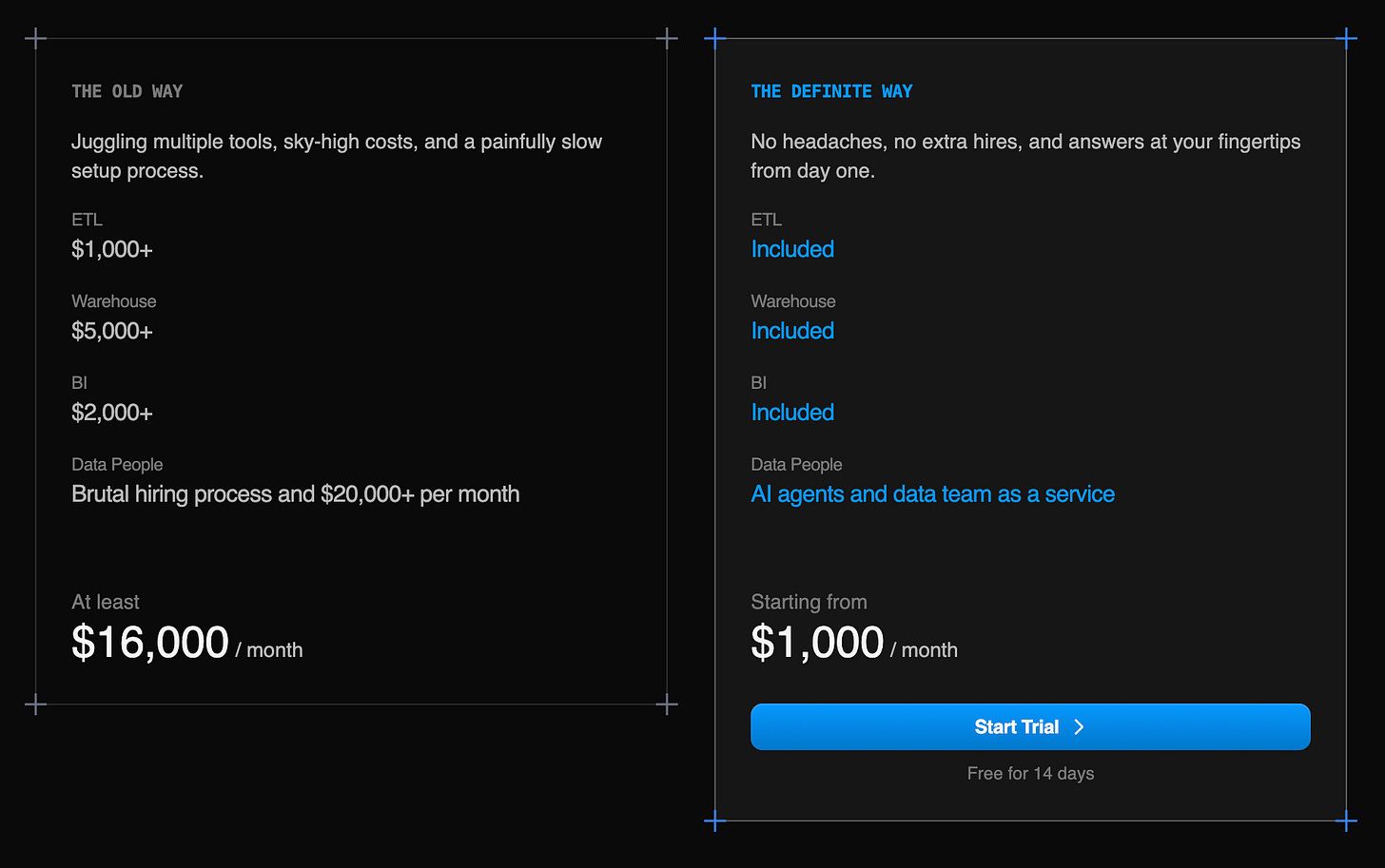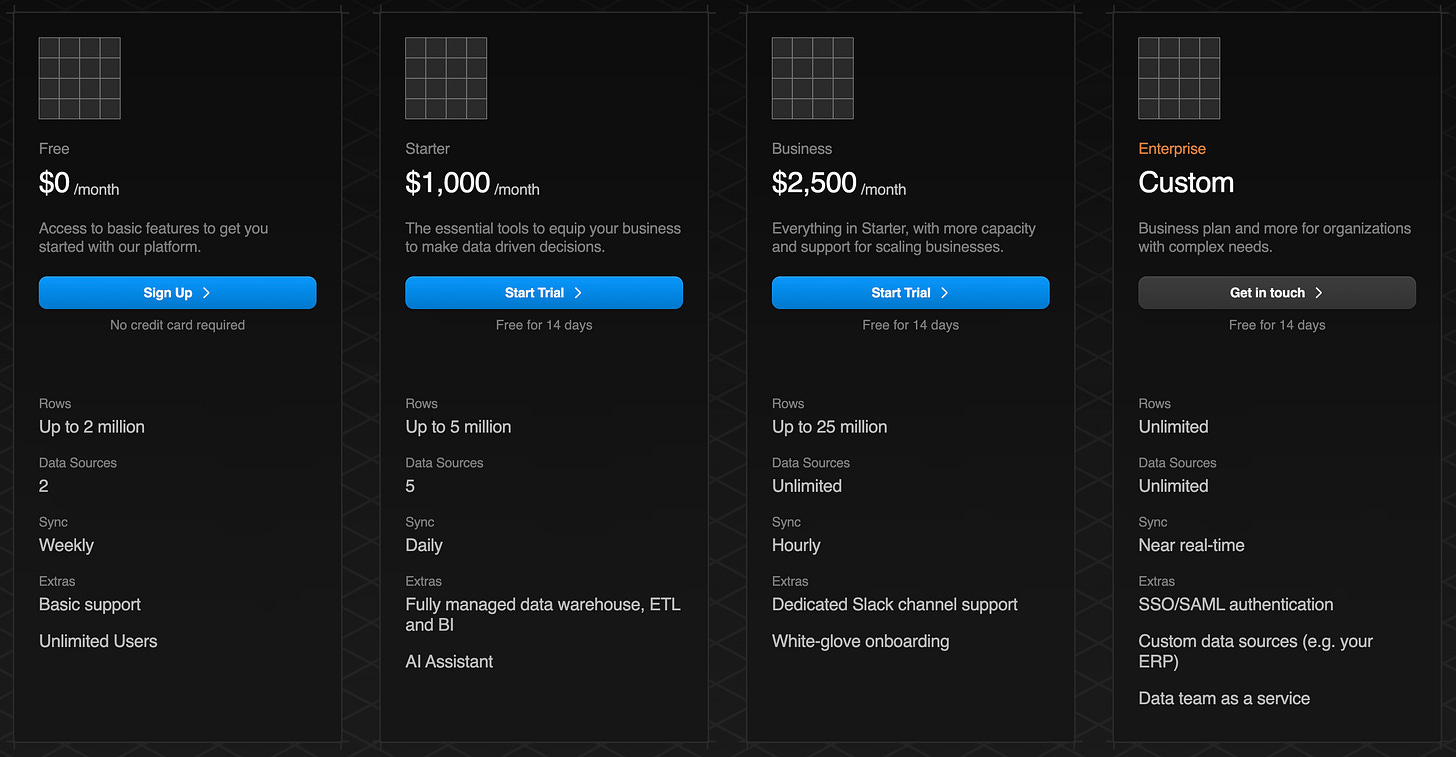Definite: Simplifying Data, All in One Place
A modern data platform that simplifies all your data needs
This article is delivered in partnership with Definite.
I learned about Definite a few months ago on LinkedIn. I don’t want to be too technical here, but I read an article explaining how Definite is using DuckDB, an analytics database, to process data efficiently behind the scenes. The article itself was really interesting in the way DuckDB was used which includes how they worked around overcoming some of DuckDB’s limitations. I was intrigued enough by Definite at this point.
This was also about the time when I had just started researching on data stacks for startups, as I had a prospect in that realm that had reached out to me for setting up their first analytics infrastructure. And I decided to dive into Definite as one of the options for this prospect.
In this article, I’ll cover what Definite is, its offerings, and whether Definite might be a good fit for you.
Here’s the section titles in this article:
What is Definite?
Definite’s Key Features
Why Choose Definite?
Limitations
Conclusion
What is Definite?
Definite is a one-stop shop for anything data. It handles from data ingestion, transformation, and to analytics all in one place with the power of AI. You connect your data source with no-code, you model data, and do your analysis directly in Definite. You won’t need to switch place between your data loading tool, your warehouse or other 100s of tools you can think of.
Definite's streamlined approach consolidates multiple tools into a single platform, reducing the mental burden of managing various applications. This minimizes the costs associated with context switching, a significant advantage of using Definite.
This also means there is less friction and disconnection across the entire data process, which helps speed up the time to insights.
Definite’s Key Features
Let’s list several key features of Definite:
Extensive Data Integration
Automated Data Modeling
Managed Data Warehouse
Integrated Analytics and Visualization
AI Assistant
Extensive Data Integration
Definite provides over 500 pre-built integrations, enabling users to connect to various data sources effortlessly. This facilitates quick data extraction without requiring custom pipeline development.
Automated Data Modeling
Definite includes tools for data modeling, creating a consistent and accurate single source of truth for metrics across the organization. Definite utilizes a tool called Cube under the hood.
A simple example of this is the below screenshot. I connected my google analytics data to Definite, and it auto-populated Cube models for me. Now, I’m ready to start my analysis out-of-the box (you also see models for Attio, a CRM source I previously brought in):
Not to mention that you can create your own custom models as well!
Managed Data Warehouse
The platform offers a fully managed and secure data warehouse, ensuring a centralized and reliable repository for all organizational data. Definite allows you to plug your cloud data warehouse or to use Definite’s built-in data warehouse powered by DuckDB.
Once you ingested your data and/or connected your cloud data warehouse, you’ll have options to choose which database you want to use for your analysis in Definite’s Canvas:
Integrated Analytics and Visualization
Users can create customizable dashboards, visualizations, and custom queries through the Definite’s intuitive interface, called Canvas. You can start doing analytics right in the same platform you did data ingestion and modeling.
The below screenshot shows my analysis showing google analytics average daily active users by month. I created a table (Slice, is the name Definite uses) and added a line chart based off of that table.
Notice that I haven’t written a single line of code from data ingestion and to modeling and analysis.
AI Assistant
Definite features an AI assistant that comprehends organizational data, providing instant insights and facilitating data-driven decision-making. With its AI assistant, Fi, users can pose questions in plain English, such as "Show me the average trip distance for Lyft on weekends," and receive immediate, actionable insights.
Let’s see this in action. I’ll do the same analysis I did above by using Definite’s built-in AI:
This is amazing. You can easily add the generated chart to your Canvas as well. If you don’t like the chart selection, you always have the option to re-prompt or modify it by yourself.
Honestly, this AI integration may be the most exciting feature to me out of all that Definite offers.
Why Choose Definite?
We’ve already covered the key features of Definite, so you may not need to hear this, but let me take a step back and explain why you might want to use it.
We know that not every business has the time and resources to do analytics fast enough. Startups, in particular, need to move fast, often prioritizing action over perfection. But even with their best efforts, ingesting, modeling, and analyzing data takes time. By the time insights are ready, the market has already shifted.
I've seen teams manually extracting data from multiple sources, merging everything into an Excel sheet, and running calculations just to deliver a simple analysis. They do this because they need to move fast, even though they know there’s a better, more automated way.
The problem? A lack of time and resources to build it the better way.
Definite changes that. It automates the key steps in doing analytics, eliminating manual work and ensuring you get actionable insights when they matter most. And their AI capability accelerates your analytics even faster. You type your questions you want to answer and their AI will build queries and charts automatically for you.
Definite is a great fit for small data teams, data practitioners at startups, and even non-technical users who find themselves managing data processes. It simplifies analytics, reducing the complexity of working with multiple tools while enabling faster insights.
Then you may ask, why not use other data tools to address this exact problem? The answer is yes, you can use whichever tools you prefer, but each comes with costs, both financial and in terms of the resources required for implementation.
We've seen that Definite, as a fully managed tool, eliminates the resource burden of implementation. But what about the financial aspect? Let’s take a closer look.
Below is a screenshot from Definite’s website, highlighting its strengths in pricing:
Without Definite, you have at least a few systems you have to manage that may cost something like a few grand each.
In addition, they offer a decent free tier to get you started with no financial commitment. I love when a tool provides a generous free tier. It gives you a head start and helps you understand the potential benefits before making a commitment.
The free tier allows you to use up to 2 million rows of data with unlimited users. Once your data needs grow, you can upgrade to something like the Starter plan, which costs $1,000/month and it offers::
A fully managed data platform
Integrations with up to 5 data sources
Up to 5 million rows ingested
Daily sync
AI assistent
Once you need to scale up your data volume, then you’ll have to upgrade to an upper plan and the price will be bumped up to $2,500/month or more. It may seem not so cheap, but considering everything from data ingestion to BI is in one place, I’d say this is very reasonable. Imagine paying a company like Fivetran $500 per connector per 1 million rows just to ingest data into your data warehouse (based on Fivetran’s pricing estimator). Definite is much more economical.
So, why should you choose Definite?
You want to spend less time preparing data and more time on actual analysis.
You want to harness the power of AI for data engineering, modeling, and analytics, all in one platform.
You need to move fast and iterate quickly without being slowed down by data bottlenecks.
Limitations
Given Definite is still young as a product and a company, the documentation and support community might be limited. This is true across any newer data tools though.
Another consideration is the potential lack of integrations. While you can connect to dbt, both dbt Cloud and dbt Core, integrating a separate BI tool you already have with Definite may not be straightforward (this is possible via Cube’s SQL API). It might be interesting to see SQLMesh integration down the road as well.
And lastly but not least, Definite still requires you to learn some of their components such as writing models in Cube and learning to use Canvas, their analysis layer.
Conclusion
Definite has a lot of potential. I'm confident that the direction Definite is taking represents the future way of working for many data teams, leveraging AI and automating processes so you can focus solely on analysis. Definite is already spearheading this effort by building a platform that enables this shift.
Lastly, here’s a few links that might be helpful in getting you started with Definite:


